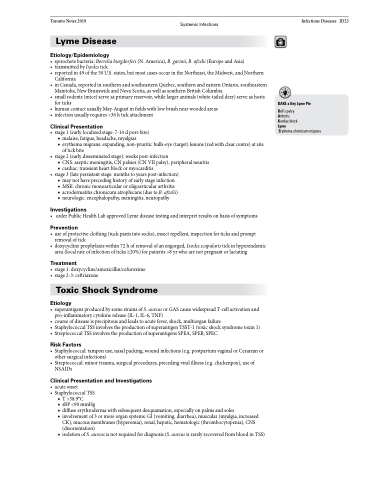Page 623 - TNFlipTest
P. 623
Toronto Notes 2019 Systemic Infections Lyme Disease
Etiology/Epidemiology
• spirochetebacteria:Borreliaburgdorferi(N.America),B.garinii,B.afzelii(EuropeandAsia)
• transmittedbyIxodestick
• reportedin49ofthe50U.S.states,butmostcasesoccurintheNortheast,theMidwest,andNorthern
California
• inCanada,reportedinsouthernandsoutheasternQuebec,southernandeasternOntario,southeastern
Manitoba, New Brunswick and Nova Scotia, as well as southern British Columbia
• smallrodents(mice)serveasprimaryreservoir,whilelargeranimals(white-taileddeer)serveashosts
for ticks
• humancontactusuallyMay-Augustinfieldswithlowbrushnearwoodedareas • infectionusuallyrequires>36htickattachment
Clinical Presentation
• stage1(earlylocalizedstage:7-14dpost-bite)
■ malaise, fatigue, headache, myalgias
■ erythema migrans: expanding, non-pruritic bulls-eye (target) lesions (red with clear centre) at site
of tick bite
• stage2(earlydisseminatedstage):weekspost-infection
■ CNS: aseptic meningitis, CN palsies (CN VII palsy), peripheral neuritis
■ cardiac: transient heart block or myocarditis
• stage3(latepersistentstage:monthstoyearspost-infection)
■ may not have preceding history of early stage infection ■ MSK: chronic monoarticular or oligoarticular arthritis ■ acrodermatitis chronicum atrophicans (due to B. afzelii) ■ neurologic: encephalopathy, meningitis, neuropathy
Investigations
• order Public Health Lab approved Lyme disease testing and interpret results on basis of symptoms
Prevention
• useofprotectiveclothing(tuckpantsintosocks),insectrepellent,inspectionforticksandprompt removal of tick
• doxycyclineprophylaxiswithin72hofremovalofanengorged,Ixodesscapularistickinhyperendemic area (local rate of infection of ticks ≥20%) for patients >8 yr who are not pregnant or lactating
Treatment
• stage1:doxycycline/amoxicillin/cefuroxime • stage2-3:ceftriaxone
Toxic Shock Syndrome
Etiology
• superantigensproducedbysomestrainsofS.aureusorGAScausewidespreadT-cellactivationand pro-inflammatory cytokine release (IL-1, IL-6, TNF)
• courseofdiseaseisprecipitousandleadstoacutefever,shock,multiorganfailure
• StaphylococcalTSSinvolvestheproductionofsuperantigenTSST-1(toxicshocksyndrometoxin1)
• StreptococcalTSSinvolvestheproductionofsuperantigensSPEA,SPEB,SPEC
Risk Factors
• Staphylococcal:tamponuse,nasalpacking,woundinfections(e.g.postpartumvaginalorCesareanor other surgical infections)
• Streptococcal:minortrauma,surgicalprocedures,precedingviralillness(e.g.chickenpox),useof NSAIDs
Clinical Presentation and Investigations
• acuteonset
• StaphylococcalTSS
■ T>38.9°C
■ sBP <90 mmHg
■ diffuse erythroderma with subsequent desquamation, especially on palms and soles
■ involvement of 3 or more organ systems: GI (vomiting, diarrhea), muscular (myalgia, increased
CK), mucous membranes (hyperemia), renal, hepatic, hematologic (thrombocytopenia), CNS
(disorientation)
■ isolation of S. aureus is not required for diagnosis (S. aureus is rarely recovered from blood in TSS)
Infectious Diseases ID23
BAKE a Key Lyme Pie
Bell’s palsy Arthritis Kardiac block Lyme
Erythema chronicum migrans


